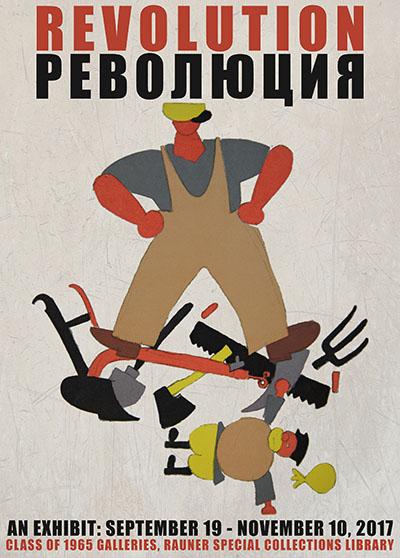Hope and Despair
Two of these books are designed to inspire the world through an aggressive assertion of the economic benefits of communism. The Struggle for Five Years in Four uses “Isotypes” to present data visually and graphically express economic progress. Artist Aleksander Rodchenko uses related constructivist techniques in Ten Let Uzbekistan to show the benefits of Soviet rule.
Throughout Stalin’s programs to eliminate undesirable elements of society, Rodchenko maintained a copy of his work on Uzbekistan. He used India ink to erase from history those murdered by Stalin. When artist Ken Campbell found this defaced copy in the 1990s, it inspired his monumental tribute to Rodchenko that captures the despair wrought by a brutal regime.
- Ken Campbell. Ten Years of Uzbekistan: A Commemoration. London: Ken Campbell, 1994. Presses C155cat
- The Struggle for Five Years in Four. Moscow: State Publishing House of Fine Arts, 1932. Rare HC335 S78 1932
- 10 Let Uzbekistana SSR. [Ten Years of the Soviet Socialist Republic of Uzbekistan.] Moscow: Gos. izd-vo izobrazitelʹnykh iskusstv, 1934. Rare DK941.5 D47 1934
Hope and Internationalism
The Soviet Union was a source of hope to millions around the world, many of whom saw in the Russian Revolution a vision of their own future. Some Americans, like the novelist Theodore Dreiser, traveled to Russia and reported positively on their experiences. Revolution was also exported in print and image. The works of Lenin were available in inexpensive editions which, in some instances, found their way into the hands of young revolutionaries, including Dartmouth’s Budd Schulberg, who would later be a friendly witness for the House Un-American Activities Committee and win an Academy Award for On the Waterfront. Even works originally intended for street display, like placards created for the Russian Telegraphy Agency, might be offered as revolutionary visions for Anglophone and Francophone nations and their colonies. Others, like the acclaimed and widely-influential Russian poet Alexander Blok, presented a more ambivalent vision which offended both revolutionaries and reactionaries alike.
- Theodore Dreiser. Dreiser Looks at Russia. New York: H. Liveright, 1928. Despite its sympathetic account, and Dreiser’s wild popularity in the USSR, his Dreiser Looks at Russia was suppressed in the USSR throughout the Soviet era. Rare DK267.D7
- Vladimir Illyich Lenin. The Revolution of 1917: From the March Revolution to the July Days; The Collected Works of V.I. Lenin, Volume 20. New York: International Publishers, 1929.
From the library of Budd Schulberg. Schulberg DK254 L3 A254 1929 bk1
- Vladimir Illyich Lenin. The Period of War Communism (1918-1920); V.I. Lenin, Selected Works, Volume 8. New York: International Publishers, [1937]. From the library of Budd Schulberg. Schulberg DK254 L3 A254 1937
- Aleksandr Aleksandrovich Blok. Dvienadtsatʹ. [The Twelve.] Petersburg: "Alkonost," 1918. Rare PG3453.B6 D8 1918
- Blok regarded this verse account of twelve Bolshevik soldiers marching through a snowy Saint Petersburg as his finest work. Blok died in 1921, unable to take advantage of permission to seek medical care abroad. His friend, the poet Maksim Gorky, pressured Soviet officials for his release, warning they risked responsibility for the death of Russia’s greatest poet.
- Russian Placards, 1917-1922. 1st part / Petersburg Office of the Russian Telegraph Agency (ROSTA) = Le placard russe, 1917-1922. Première série / Agence thélégraphique [sic] russe (ROSTA) à Pétersbourg. Petersburg: Petersburg Branch of the News of the All-Russia Central Executive Committee ("Isvestia VCIK"), 1923. “Agitation for work-cooperation. The workman stands triumphantly before the implements of industry; at his feet lies a marauder vanquished by the system of cooperation.” Rare DK265.R8342 1923
